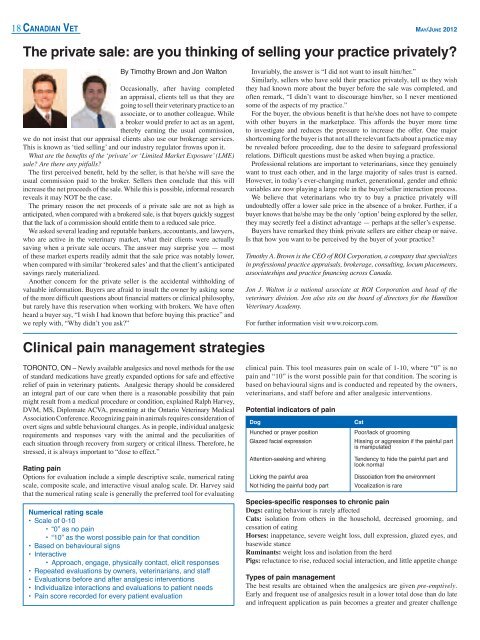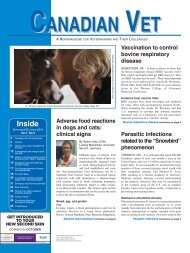canadian vet - K2 Animal Health Publishing
canadian vet - K2 Animal Health Publishing
canadian vet - K2 Animal Health Publishing
You also want an ePaper? Increase the reach of your titles
YUMPU automatically turns print PDFs into web optimized ePapers that Google loves.
18 Canadian Vet<br />
May/June 2012<br />
The private sale: are you thinking of selling your practice privately?<br />
By Timothy Brown and Jon Walton<br />
Occasionally, after having completed<br />
an appraisal, clients tell us that they are<br />
going to sell their <strong>vet</strong>erinary practice to an<br />
associate, or to another colleague. While<br />
a broker would prefer to act as an agent,<br />
thereby earning the usual commission,<br />
we do not insist that our appraisal clients also use our brokerage services.<br />
This is known as ‘tied selling’ and our industry regulator frowns upon it.<br />
What are the benefits of the ‘private’ or ‘Limited Market Exposure’ (LME)<br />
sale? Are there any pitfalls?<br />
The first perceived benefit, held by the seller, is that he/she will save the<br />
usual commission paid to the broker. Sellers then conclude that this will<br />
increase the net proceeds of the sale. While this is possible, informal research<br />
reveals it may NOT be the case.<br />
The primary reason the net proceeds of a private sale are not as high as<br />
anticipated, when compared with a brokered sale, is that buyers quickly suggest<br />
that the lack of a commission should entitle them to a reduced sale price.<br />
We asked several leading and reputable bankers, accountants, and lawyers,<br />
who are active in the <strong>vet</strong>erinary market, what their clients were actually<br />
saving when a private sale occurs. The answer may surprise you — most<br />
of these market experts readily admit that the sale price was notably lower,<br />
when compared with similar ‘brokered sales’ and that the client’s anticipated<br />
savings rarely materialized.<br />
Another concern for the private seller is the accidental withholding of<br />
valuable information. Buyers are afraid to insult the owner by asking some<br />
of the more difficult questions about financial matters or clinical philosophy,<br />
but rarely have this reservation when working with brokers. We have often<br />
heard a buyer say, “I wish I had known that before buying this practice” and<br />
we reply with, “Why didn’t you ask?”<br />
Invariably, the answer is “I did not want to insult him/her.”<br />
Similarly, sellers who have sold their practice privately, tell us they wish<br />
they had known more about the buyer before the sale was completed, and<br />
often remark, “I didn’t want to discourage him/her, so I never mentioned<br />
some of the aspects of my practice.”<br />
For the buyer, the obvious benefit is that he/she does not have to compete<br />
with other buyers in the marketplace. This affords the buyer more time<br />
to investigate and reduces the pressure to increase the offer. One major<br />
shortcoming for the buyer is that not all the relevant facts about a practice may<br />
be revealed before proceeding, due to the desire to safeguard professional<br />
relations. Difficult questions must be asked when buying a practice.<br />
Professional relations are important to <strong>vet</strong>erinarians, since they genuinely<br />
want to trust each other, and in the large majority of sales trust is earned.<br />
However, in today’s ever-changing market, generational, gender and ethnic<br />
variables are now playing a large role in the buyer/seller interaction process.<br />
We believe that <strong>vet</strong>erinarians who try to buy a practice privately will<br />
undoubtedly offer a lower sale price in the absence of a broker. Further, if a<br />
buyer knows that he/she may be the only ‘option’ being explored by the seller,<br />
they may secretly feel a distinct advantage — perhaps at the seller’s expense.<br />
Buyers have remarked they think private sellers are either cheap or naive.<br />
Is that how you want to be perceived by the buyer of your practice?<br />
Timothy A. Brown is the CEO of ROI Corporation, a company that specializes<br />
in professional practice appraisals, brokerage, consulting, locum placements,<br />
associateships and practice financing across Canada.<br />
Jon J. Walton is a national associate at ROI Corporation and head of the<br />
<strong>vet</strong>erinary division. Jon also sits on the board of directors for the Hamilton<br />
Veterinary Academy.<br />
For further information visit www.roicorp.com.<br />
Clinical pain management strategies<br />
TORONTO, ON − Newly available analgesics and novel methods for the use<br />
of standard medications have greatly expanded options for safe and effective<br />
relief of pain in <strong>vet</strong>erinary patients. Analgesic therapy should be considered<br />
an integral part of our care when there is a reasonable possibility that pain<br />
might result from a medical procedure or condition, explained Ralph Harvey,<br />
DVM, MS, Diplomate ACVA, presenting at the Ontario Veterinary Medical<br />
Association Conference. Recognizing pain in animals requires consideration of<br />
overt signs and subtle behavioural changes. As in people, individual analgesic<br />
requirements and responses vary with the animal and the peculiarities of<br />
each situation through recovery from surgery or critical illness. Therefore, he<br />
stressed, it is always important to “dose to effect.”<br />
Rating pain<br />
Options for evaluation include a simple descriptive scale, numerical rating<br />
scale, composite scale, and interactive visual analog scale. Dr. Harvey said<br />
that the numerical rating scale is generally the preferred tool for evaluating<br />
Numerical rating scale<br />
• Scale of 0-10<br />
• “0” as no pain<br />
• “10” as the worst possible pain for that condition<br />
• Based on behavioural signs<br />
• Interactive<br />
• Approach, engage, physically contact, elicit responses<br />
• Repeated evaluations by owners, <strong>vet</strong>erinarians, and staff<br />
• Evaluations before and after analgesic interventions<br />
• Individualize interactions and evaluations to patient needs<br />
• Pain score recorded for every patient evaluation<br />
clinical pain. This tool measures pain on scale of 1-10, where “0” is no<br />
pain and “10” is the worst possible pain for that condition. The scoring is<br />
based on behavioural signs and is conducted and repeated by the owners,<br />
<strong>vet</strong>erinarians, and staff before and after analgesic interventions.<br />
Potential indicators of pain<br />
Dog<br />
Hunched or prayer position<br />
Glazed facial expression<br />
Attention-seeking and whining<br />
Licking the painful area<br />
Not hiding the painful body part<br />
Species-specific responses to chronic pain<br />
Dogs: eating behaviour is rarely affected<br />
Cats: isolation from others in the household, decreased grooming, and<br />
cessation of eating<br />
Horses: inappetance, severe weight loss, dull expression, glazed eyes, and<br />
basewide stance<br />
Ruminants: weight loss and isolation from the herd<br />
Pigs: reluctance to rise, reduced social interaction, and little appetite change<br />
Types of pain management<br />
The best results are obtained when the analgesics are given pre-emptively.<br />
Early and frequent use of analgesics result in a lower total dose than do late<br />
and infrequent application as pain becomes a greater and greater challenge<br />
Cat<br />
Poor/lack of grooming<br />
Hissing or aggression if the painful part<br />
is manipulated<br />
Tendency to hide the painful part and<br />
look normal<br />
Dissociation from the environment<br />
Vocalization is rare





